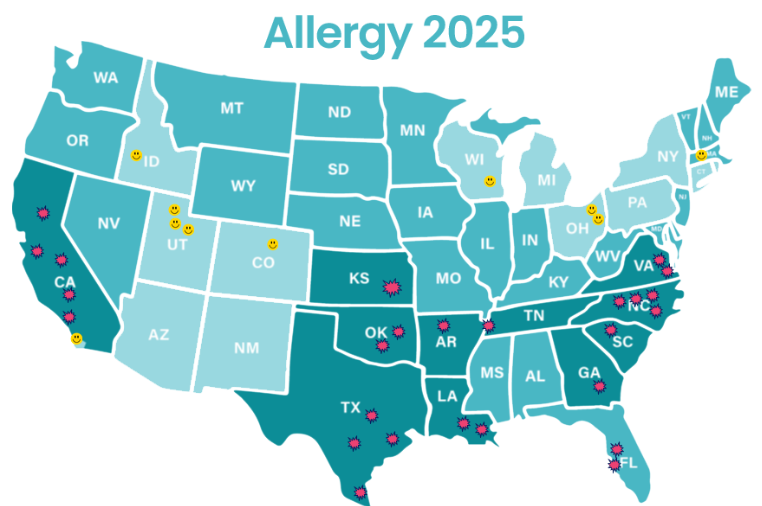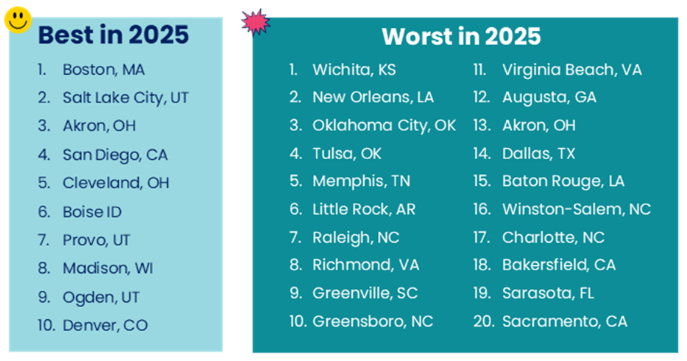
Spring Has Sprung, the Grass is Riz.
Do You Wonder Where the Bad Allergies Is?
(Spoiler: probably not where you think!)
2025 Allergy Season: Everything’s Upside Down (Including Your Sinuses)
If your spring allergies usually hit like a freight train, you might be in for some relief this year. And if you usually cruise through April without a tissue in sight… surprise! You might want to stock up.
Wait, What’s Going On?
Thanks to a weird combo of winter weather and shifting climate patterns, 2025’s spring allergy map looks a little scrambled:
- The Northeast, typically drowning in tree pollen by April, may see a milder season. Why? A colder, wetter winter delayed plant activity. Trees are slow to bloom, so pollen levels may peak later—and lower—than usual.
- Meanwhile, places like Florida and the Carolinas are facing an unusually rough season. A warm, wet winter jump-started plant growth in some areas, and now everything is blooming like it’s got something to prove.
In short: like so many things this year, spring allergies are going off-script.
2025 Allergy Capitals
Every year, the Asthma and Allergy Foundation of America puts out a report on what areas of the country will be “allergy capitals.” The foundation uses an algorithm that includes scores for medication use (bad) and allergy specialists per capita (good). Since remedy use and the number of specialists have nothing to do with how we feel when we leave the house and enter our pollen-filled environment, we have removed those numbers from the equation to create our own 2025 allergy capital map based on projected pollen counts alone. Here’s what it looks like:

The one thing that 2024 and 2025 have in common is that Wichita wins the allergy capital title for the second year in a row. Wichita is an allergy haven. It combines diverse agriculture and flora with some serious propellant. Wichita’s average wind speeds of around 13 mph facilitate the widespread distribution of pollen and other allergens. Additionally, the practice of field burning by local farmers releases smoke and particulates into the air. These airborne particles can irritate the respiratory system and compound the effects of pollen, leading to more severe allergy symptoms. I think we can count on seeing Wichita at the top of the list of allergy capitals for the foreseeable future.

Otherwise, the map shows us that major weather and environmental events in 2024 are the “gifts” that keep on giving in 2025. If you look at the sweep of allergy capitals from Texas through Louisiana, Florida and up through the Carolinas, it’s a not-so-nice trip down memory lane through the 2024 hurricane season.
When storms like hurricanes or strong winter rains sweep through, they soak the ground, break tree dormancy early, and basically throw fertilizer at everything green. Then, as the weather warms up:
- Plants bloom aggressively in response to the moisture.
- Grasses and weeds thrive, especially in flood-prone areas.
- Tree pollen gets supercharged, particularly from species like oak, birch, and pine.
This means places like Florida, the Gulf Coast, and parts of the Carolinas will have a particularly tough spring. Basically, if your power went out during a storm, expect that your allergies will be on this season.
Then there’s California. California was bipolar in late 2024. Northern California saw an extraordinary amount of rain, with some areas recording nearly twice their average precipitation. By contrast, Southern California remained unusually dry during the same period. From October 1, 2024, through January 28, 2025, Los Angeles recorded less than an inch of rain, significantly below average. And of course, the dry environment allowed wildfires to rage through some Southern California cities.
Both these extremes created allergy capitals. We know how the rain works, but the fires had a similar outcome. The destruction of vegetation during wildfires can release large quantities of pollen and mold spores into the air, further aggravating allergy symptoms. The combination of smoke inhalation and increased airborne allergens has created a challenging environment this spring.
The Frigid Flip Side
Although most experts agree that climate change is driving up Earth’s average temperatures, which will, in turn, create more intense allergy seasons moving forward, this winter was a particularly cold one in the Northeast (it’s still pretty cold). Allergy season is basically a plant party, and cold weather is the bouncer that keeps things in check. A prolonged, colder winter delays the bloom cycle for trees and other pollen-producing plants and shortens the overall pollen season, since plants have less time to release their pollen.
This is why the chilly Northeast will get a later and lighter allergy season—at least for tree pollen. In short: colder winters can hit the pause button on pollen, and this year, the Northeast might actually get to enjoy spring before the sneezing starts.
What Should We Do with All This Info?
Even if you’ve had your allergy routine on lock, this season might call for a few tweaks. Here’s what the experts recommend:
Start Preventatively
Don’t wait until your eyes are itching to act. Start using antihistamines, nasal sprays, or allergy meds before symptoms flare—especially if you’re in a region likely to have unusual pollen levels this year. An antihistamine will prevent you from becoming symptomatic when you are exposed to allergens. If you generally use a corticosteroid nasal spray, remember that it takes five to seven days to kick in, so it’s a good idea to begin the process. Remember to take non-drowsy antihistamines during the day and different medication at night. It’s hard to get anything done if you are falling asleep on your feet.
Nip Early Symptoms in the Bud (Pun intended!)
If symptoms have started, try allergy meds with a decongestant. Most brands of antihistamines have a decongestant version. If you are very congested, try the -D versions until your symptoms lessen. Then, go back to your usual medication. Remember to be careful if you also take ADHD medication since both have stimulant effects.
Mask Up (Seriously)
Remember masks? They still work—especially for filtering out pollen during yard work or high-pollen days. A bonus: they also block some air pollution, which can worsen allergies.
Leave Your Shoes at the Door
Even if you’ve taken your medication, sprayed your nose, and worn a mask, it won’t help much if you track pollen into your home. During allergy season, make it a habit to have everyone remove their shoes before entering your home. It can make a huge difference.
Rinse It Off
Pollen clings to clothes, skin, and especially hair. Showering at night and tossing your outdoor clothes in the hamper can cut down exposure while you sleep. (No one wants to cuddle their pillow and 10,000 pollen grains.)
Upgrade Your Air Game
Use a HEPA filter in your bedroom. Keep windows closed on high-pollen days. And check your car’s cabin air filter—it’s easy to forget, but it’s your nose’s first line of defense when you’re driving through tree-lined streets.
Still Underrated: Nasal Rinses and Saline Sprays
Saline rinses (like neti pots or squeeze bottles) are one of the few things that actually flush allergens out of your nasal passages. They’re not new, but they’re still one of the most effective, underused tools out there. Just make sure you use sterile or distilled water, not tap. Even more overlooked are saline nose sprays you can buy in the “cold and allergy” aisle. They are terrific multipurpose weapons in the war against allergy symptoms. They flush pollen, dust, and other irritants out of your nasal passages, reducing exposure and inflammation. They also moisturize dry nasal tissue—particularly helpful if you’re also using drying meds like antihistamines or decongestants. Unlike medicated nasal sprays, saline sprays don’t cause rebound congestion and can be used multiple times a day. Pro tip: look for “isotonic” or “buffered” saline if you’re sensitive—some sprays feel more gentle than others.
Thunderstorms: Great for Drama, Terrible for Allergies
Rain and pollen have a love-hate relationship. Rain showers often provide relief for allergy sufferers because rain can temporarily clear pollen from the air. But thunderstorms can actually increase pollen counts since lightning, wind, and temperature changes can stir things up.
Check with a Medical Provider if Symptoms Surge
Some newer prescription treatments or allergy shots (immunotherapy) may be worth considering—especially if your allergies seem worse than usual this year. If you are really suffering, it’s worth a conversation.
The Bottom Line on Allergies 2025
First, rest assured that if your allergy symptoms feel different this year, it’s because allergy season is different this year. Second, there is no time like the present to get started. Begin your routine before symptoms start and consider masking for a month or two. Do whatever you can to keep pollen out of your eyes, nose, and home— because your sinuses shouldn’t be as reactive as the news cycle.